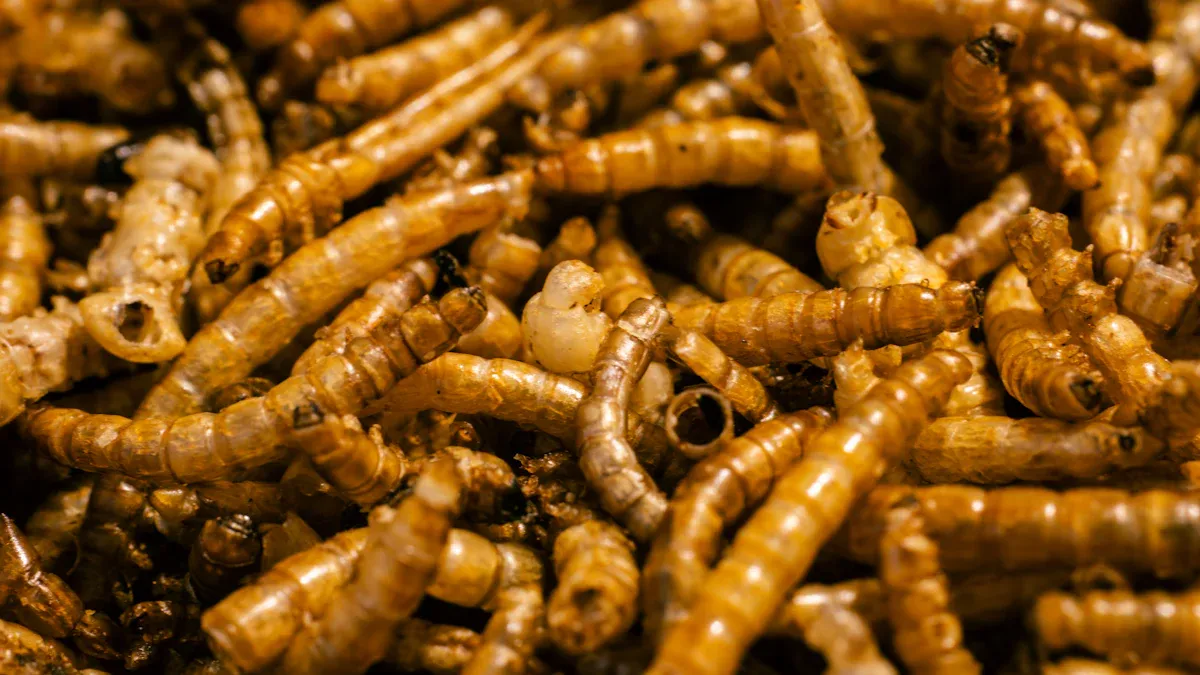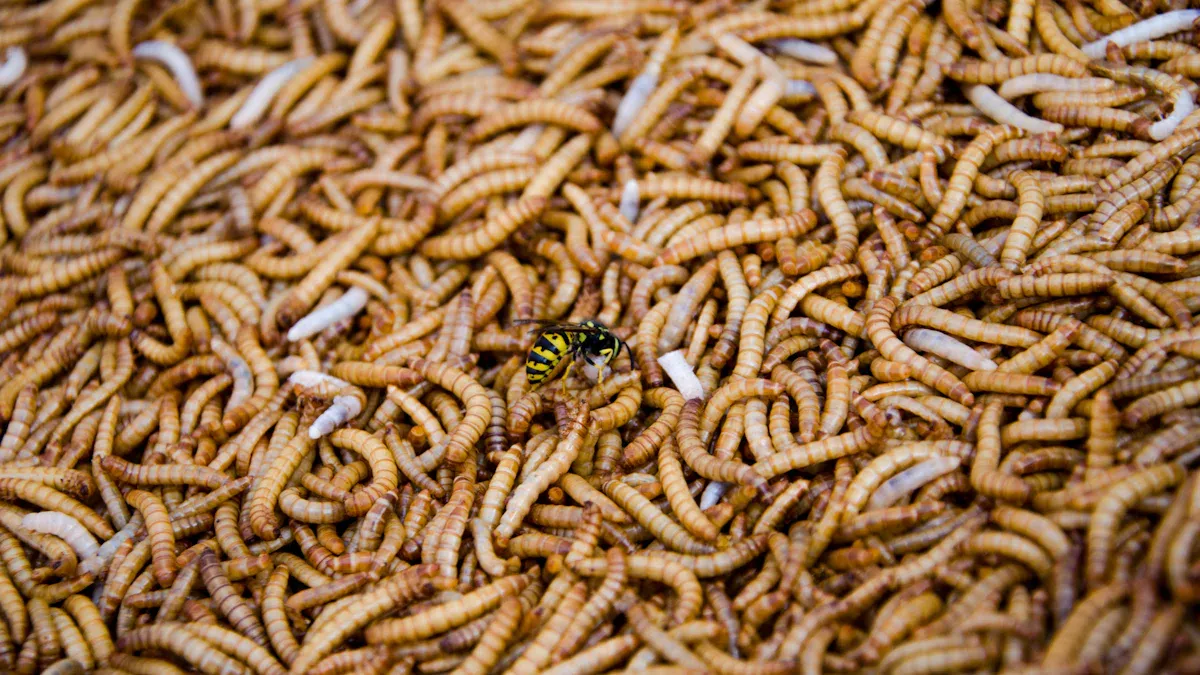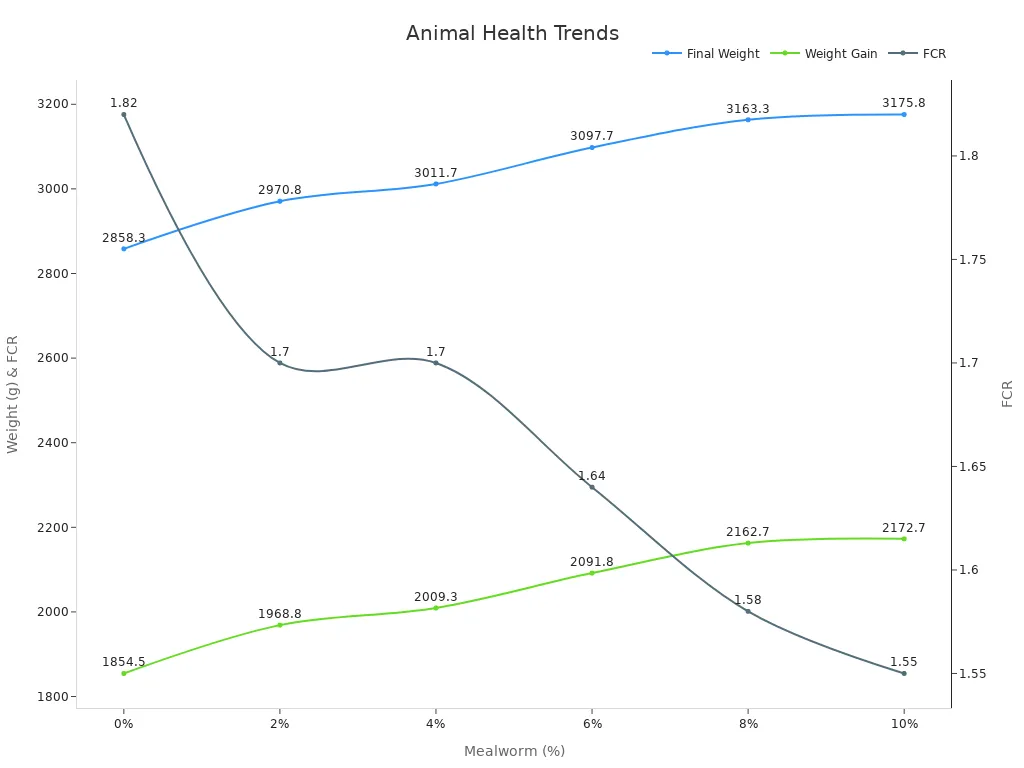
Dried Mealworms for Farms offer a powerhouse of nutrition. They pack around 50 grams of protein per 100 grams, making them a top choice for animal feed. These tiny wonders also deliver essential amino acids, fatty acids, and vitamins. Plus, their eco-friendly production requires less water, land, and energy compared to traditional livestock farming.
キーテイクアウト
- Dried mealworms have 50 grams of protein in 100 grams. They are a great choice to help animals grow and stay healthy.
- Adding dried mealworms to chicken feed makes eggs better. The shells get stronger, and the yolks become richer, which can sell for more money.
- Mealworms are a green protein source. They need less land, water, and energy than regular livestock. This helps farms stay eco-friendly.
乾燥食虫の栄養的利点

High Protein Content for Animal Growth
Protein is essential for animal growth, and dried mealworms deliver it in abundance. They contain approximately 50.9 grams of protein per 100 grams, making them a superior choice for farm animals. To put this into perspective, here’s how mealworms compare to other insects:
| Insect Type | Protein Content (g/100g, dry weight) |
|---|---|
| Mealworms | 50.9 |
| Crickets | 54.9 |
| Locusts | 46.6 |
This high protein content supports muscle development, tissue repair, and overall growth in animals. Farmers looking to enhance the health and productivity of their livestock can rely on dried mealworms for farms as a consistent and nutrient-dense feed option.
Rich in Vitamins and Natural Oils
Dried mealworms are more than just a protein source. They are packed with essential nutrients that contribute to a balanced diet for animals. These include:
- Proteins, fats, and essential amino acids.
- Vitamins and minerals like Calcium, Iron, and Manganese.
- Beneficial fatty acids such as myristic acid, palmitic acid, and oleic acid.
These nutrients play a vital role in maintaining the health of farm animals. For example, Calcium supports strong bones, while Iron prevents deficiencies. The natural oils in mealworms also promote healthy skin and shiny coats, especially in poultry and livestock.
Boosting Immunity and Egg Quality in Poultry
Farmers often notice significant improvements in poultry health when they include dried mealworms in their feed. The rich nutrient profile of mealworms strengthens the immune system, helping birds resist common diseases. Additionally, the high protein and fatty acid content enhance egg quality. Hens fed with mealworms tend to produce eggs with stronger shells and richer yolks.
By incorporating dried mealworms for farms into poultry diets, farmers can achieve better productivity and healthier flocks. It’s a simple yet effective way to boost both animal well-being and farm output.
Uses of Dried Mealworms on Farms
Feeding Poultry for Better Egg Production
Farmers often turn to dried mealworms for farms to improve egg production in poultry. These nutrient-packed insects provide the protein and fatty acids hens need to thrive. When hens consume mealworms regularly, their eggs often have stronger shells and richer yolks. This boost in egg quality can lead to higher market value and better customer satisfaction.
Mealworms also help maintain the health of the flock. Their natural oils promote shiny feathers and healthy skin, while vitamins like calcium and iron support bone strength and overall vitality. By adding dried mealworms to poultry feed, farmers can ensure their birds stay productive and healthy year-round.
Mealworms as Feed for Aquaculture
Aquaculture farmers increasingly use dried mealworms as a sustainable feed option. These insects offer a high-protein alternative to traditional fish feeds, which often rely on fishmeal. A study on post-smolt salmon revealed that mealworm meal does not hinder growth rates when included at lower levels in their diet. Nutrient absorption remains consistent, ensuring fish grow healthily without compromising protein quality.
Mealworms also align with eco-friendly practices in aquaculture. Their production requires fewer resources than fishmeal, reducing the environmental impact of fish farming. Farmers can incorporate dried mealworms into their feeding strategies to support both sustainable practices and optimal fish growth.
Benefits for Pigs and Other Livestock
Dried mealworms for farms aren’t just for poultry and fish—they’re also beneficial for pigs and other livestock. Studies show that insect supplementation in weaning pigs’ diets enhances growth performance and nutrient digestibility. Farmers notice improved weight gain and healthier animals when mealworms are part of the feed.
- Mealworms provide essential nutrients without altering pigs’ metabolism.
- Their high protein content supports muscle development and tissue repair.
- Natural oils promote healthy skin and coats in livestock.
Adding mealworms to livestock diets is a simple way to boost animal health and farm productivity.
Feeding Methods and Storage Tips
Feeding dried mealworms is straightforward, but farmers can optimize their use with effective methods and proper storage. For example, mealworms thrive on wheat bran mixed with vegetables like cabbage or broccoli. Farmers can adjust the quantity based on consumption, ensuring animals get the right amount of nutrients.
| Feeding Method | Conditions | Details |
|---|---|---|
| Wheat Bran with Vegetables | 25°C, 60-70% RH | Mealworms were fed 25-50g of fresh cabbage or broccoli daily, adjusted for consumption. |
For storage, refrigeration works well for short-term needs. Blanched mealworms stay fresh for 10-12 days, while steamed mealworm pastes can last up to three weeks at 4°C. However, pastes should be used within 14 days to maintain quality. Proper storage ensures farmers get the most out of their dried mealworms, keeping them fresh and ready for feeding.
Cost and Accessibility of Dried Mealworms
Pricing and Affordability
Dried mealworms are gaining popularity as a cost-effective protein source for farms. Their affordability stems from efficient production methods that require fewer resources compared to traditional protein sources like soy or fishmeal. The market for mealworms is also expanding rapidly. In 2023, the global market size reached USD 0.18 million, with a projected compound annual growth rate (CAGR) of 26.20% through 2030. This growth reflects increasing demand for sustainable and nutrient-rich feed options.
Farmers often find dried mealworms to be a smart investment. While initial costs may vary depending on the supplier, the long-term benefits—such as improved animal health and productivity—make them a worthwhile addition to farm operations.
Availability in Local and Online Markets
Dried mealworms are widely available in both local and online markets, making them accessible to farmers everywhere. Online platforms offer a variety of options, often with detailed descriptions to help buyers choose the right product. Here’s a quick look at some popular offerings:
| Product Name | コンテンツ | Price |
|---|---|---|
| Trade King Mealworms | 100% natural whole-dried mealworms with 51% protein value. Re-sealable pouch. | N/A |
| Medium Mealworms (3/4″) | Recurring purchase option with flexible cancellation policies. | N/A |
| Dried Mealworms | MSRP: Now: $11.51 | $11.51 |
Local feed stores also stock dried mealworms, catering to farmers who prefer in-person purchases. This dual availability ensures that farmers can easily incorporate mealworms into their feeding routines.
その他のタンパク質源との比較
When compared to traditional protein sources, dried mealworms stand out for their efficiency and effectiveness. Studies highlight their advantages:
| Study | Findings |
|---|---|
| Toviho & Bársony (2022) | Substituting fish or soybean meal with mealworms improved growth performance. |
| Makkar et al. (2014) | Egg production increased by 2.4% with the use of dry mealworms. |
| Gasco et al. (2019) | Dietary insect meals significantly improved digestibility. |
Mealworms not only match but often surpass the nutritional benefits of fishmeal and soy. Their production also has a lower environmental impact, making them a sustainable choice for modern farming. Farmers looking for a high-protein, eco-friendly feed option will find dried mealworms to be a valuable alternative.
Sustainability and Environmental Impact
Eco-Friendly Production of Mealworms
Mealworm farming stands out as an eco-friendly option for protein production. Unlike traditional livestock farming, mealworms require less land, water, and energy. Their feed conversion ratio (FCR) is highly efficient, meaning they produce more protein with fewer resources. For example, mealworms consume plant-based feed and convert it into high-quality protein without generating significant greenhouse gases.
| Indicator | Measurement Unit | コンテンツ |
|---|---|---|
| Global Warming Potential (GWP) | CO2-equivalents | Sum of CO2, CH4, and N2O emissions, expressed in CO2-eq. |
| Fossil Energy Use (EU) | Mega joules (MJ) | Total energy consumption from fossil sources in the production process. |
| Land Use (LU) | m² per year | Area required for mealworm production, including feed and other inputs. |
| Feed Conversion Ratio (FCR) | Ratio | Amount of concentrates used per kg of live mealworms produced. |
These indicators highlight the sustainability of mealworm farming, making it a smart choice for eco-conscious farmers.
Reduced Carbon Footprint in Farming
Mealworms help reduce the carbon footprint of farming operations. Their production emits fewer greenhouse gases compared to livestock like cattle or pigs. Direct emissions from mealworms, such as CO2 and methane, are minimal. Farmers who switch to mealworms as a protein source can significantly lower their environmental impact.
Additionally, mealworms require less fossil energy during production. This makes them a sustainable alternative to traditional protein sources like fishmeal or soy. By adopting mealworm-based feeds, farms can contribute to global efforts to combat climate change.
Supporting Circular Farming Practices
Mealworms play a key role in circular farming systems. They can consume agricultural byproducts, including crops contaminated with aflatoxins, and convert them into safe, high-quality protein. A study showed that yellow mealworms fed contaminated corn produced insect meal suitable for fish feed without harming fish health.
| Aspect | Details |
|---|---|
| Study Focus | Utilization of aflatoxin B1 contaminated corn by yellow mealworms for fish feed |
| Mycotoxin Concentration | Highest applied concentration was 415 µg/kg, significantly above EU threshold |
| Insect Mortality | No increase in mortality observed after five weeks, even at high contamination levels |
| Mycotoxin in Insect Body | Detected at 2.2 µg/kg only in the highest concentration group |
| Fish Feeding Results | Insect meal from contaminated crops showed no significant negative effects on fish fries compared to controls |
| Frass Toxicity | High levels of toxicity observed in frass from highly contaminated groups, highlighting responsible usage needs |
This ability to recycle waste into valuable feed aligns with circular farming principles. Farmers can use mealworms to reduce waste and create sustainable protein sources, benefiting both the environment and their operations.
Dried Mealworms for Farms offer a practical and sustainable solution for modern farming. Their high protein content improves animal health, growth, and productivity. Studies show that increasing mealworm percentages in feed significantly boosts final body weight, weight gain, and feed conversion ratios.
| Parameters | 0% | 2% | 4% | 6% | 8% | 10% | P-value |
|---|---|---|---|---|---|---|---|
| Final body weight (g) | 2858.3 | 2970.8 | 3011.7 | 3097.7 | 3163.3 | 3175.8 | < 0.001 |
| Body weight gain (g) | 1854.5 | 1968.8 | 2009.3 | 2091.8 | 2162.7 | 2172.7 | < 0.001 |
| Feed conversion ratio | 1.82 | 1.70 | 1.70 | 1.64 | 1.58 | 1.55 | < 0.001 |

Farmers can align with sustainable farming goals by incorporating mealworms into feeding strategies. These nutrient-dense insects not only enhance animal well-being but also reduce environmental impact.
Exploring dried mealworms as a feed option is a step toward healthier animals and eco-friendly farming practices.
Author: Felix
よくある質問
What animals can eat dried mealworms?
Farmers use dried mealworms for poultry, pigs, fish, and other livestock. They’re versatile and packed with nutrients that benefit a wide range of animals. 🐓🐖🐟
乾燥食虫の保存方法は?
Store them in a cool, dry place or refrigerate for freshness. Proper storage prevents spoilage and keeps nutrients intact for feeding.
Are dried mealworms eco-friendly?
Yes! Mealworms require fewer resources to produce, emit minimal greenhouse gases, and support sustainable farming practices. They’re a green choice for modern farms. 🌱


